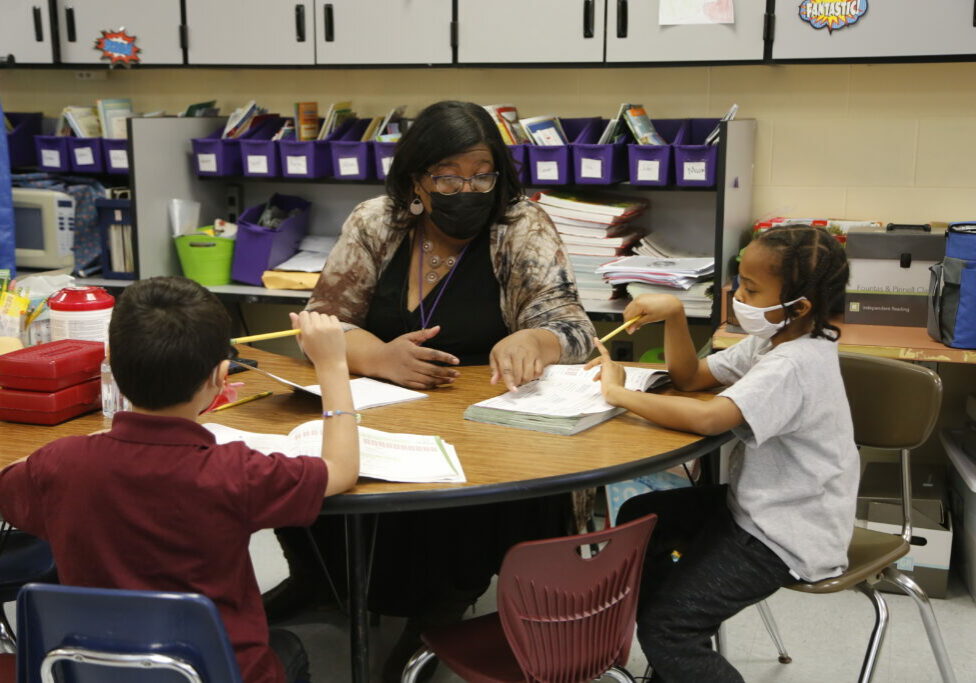How the first cohort of teacher leaders are using their endorsement
By Richard Wilson
A leader in every seat: this is one of the key tenets of the NJEA Teacher Leader Academy (TLA), a state approved program that leads members to the New Jersey teacher leader endorsement. Imagine a school district in which teacher voice is elevated in a true model of shared decision making. That is the visionary promise of teacher leadership.
In 2015, the teacher leader endorsement was established through legislation strongly supported by NJEA. It took four years to work through the regulatory process, and in early 2020, NJEA opened its own Teacher Leader Academy to lead candidates to the endorsement.
But this endorsement was unlike any other license issued by the New Jersey Department of Education. Every other certificate or endorsement is a license to do a particular job, or to teach a particular cluster of classes. Someone with an instructional certificate and an elementary endorsement can teach in an elementary classroom. The students with disabilities endorsement will allow someone to teach students eligible for special education services. At the secondary level, a subject area endorsement allows one to teach classes within a specific subject area. But what exactly does one do with a teacher leader endorsement?
Approved programs of study that lead to the endorsement are required to be based on a set of standards commonly referred to as the Teacher Leader Model Standards. Developed in 2010, these standards cover a wide range of areas commonly addressed by teacher leaders, from fostering collaborative cultures to professional learning to advocating for students and the profession. Depending on a teacher’s work context and their own passions and interests, teacher leadership exhibits itself in a great variety of ways.
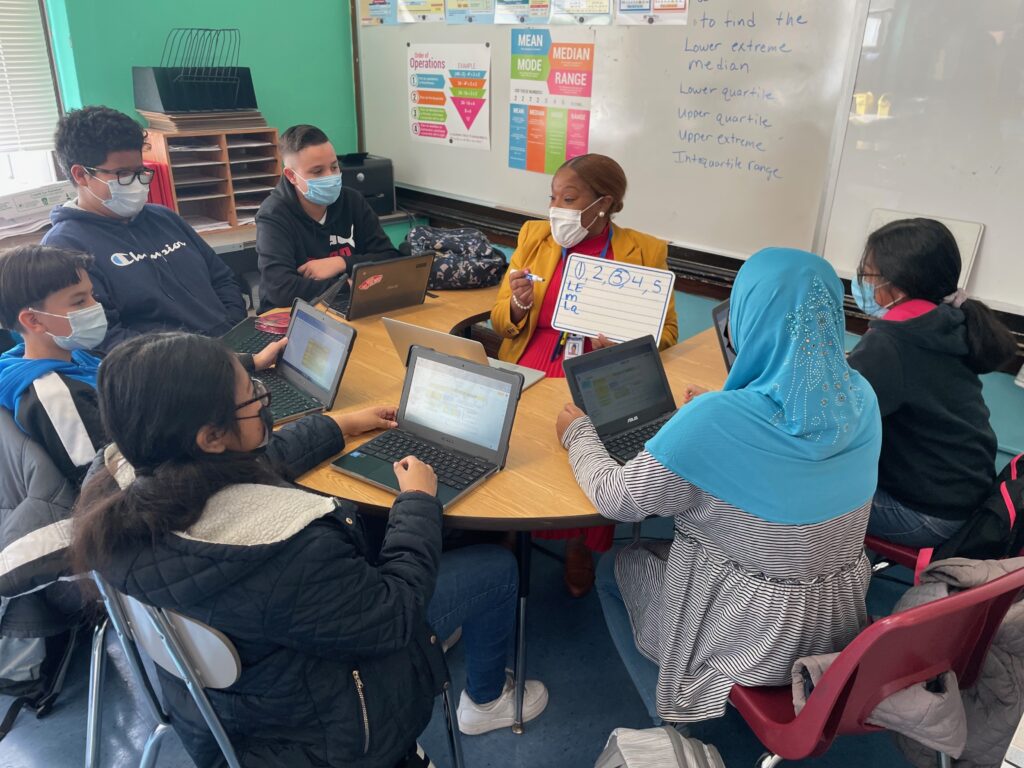
So, we return to the question: What exactly does one do with the teacher leader endorsement? In recognition of the variety of ways in which teacher leadership shows itself, there is not yet a prescribed list of job titles from the Department of Education that the endorsement entitles its holders to attain. The New Jersey Teacher Leader Advisory Board, which studied the issue for two years to advise the Department of Education on regulations, recommended that it be up to local school districts to decide how best to use the endorsement and that it would be foolish to try to develop a list of “jobs” at the statewide level.
One way to look at the endorsement and how it can be used is to follow those who were among the first to earn the endorsement. The NJEA TLA graduated its first cohort in the spring of 2021. Recently, we went back to visit with some of the graduates to ask them how they have used the endorsement in the year that followed.
Even with all the restrictions that the pandemic brought in the last year, we discovered that some of the TLA graduates found ways to use their new understandings in their own districts while others went outside their districts to explore leadership opportunities, both in nonprofit and union spaces. Many TLA graduates have been active in some combination of district, nonprofit and union spaces. But wherever they have exerted their leadership, it has been to build the capacity of their peers in order to better the lives of their students and the communities in which they work.
Leading in special education
Justin Saxon is a teacher in the therapeutic intervention program at Northern Valley Regional School District. He has been a longtime advocate for teacher leadership. The Northern Valley Regional School District has a long history of high quality professional learning for the high school and the seven elementary districts that send students to the high school.
As a special educator, Saxon knew that the needs of special educators could be met in the districts’ shared professional development center. Using some of what he had learned as a student in the teacher leader academy, he advocated for those needs among the superintendents of all eight districts in the Northern Valley region.
Saxon was able to carve out new duties for himself this year. He continued to teach while spending several periods a day engaging in professional learning for special educators. This year, he took on building capacity with colleagues in the therapeutic intervention program, as well as building a sustained professional learning pathway around social and emotional learning (SEL) in Demarest, one of the elementary districts that is part of the regional system. That pathway included 12 formal learning sessions on SEL coupled with individual coaching for all the teachers and paraprofessionals who signed up to be part of the program.
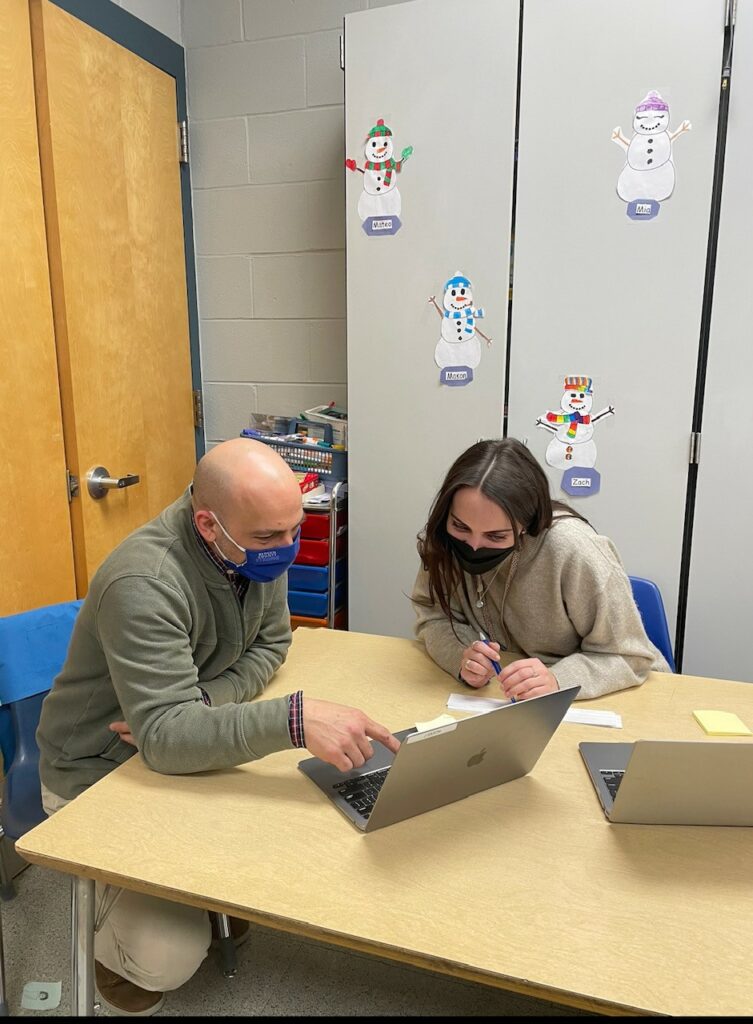
Teacher Leader Justin Saxon in a coaching session with special education teacher Ashley Graham at Northern Valley Regional schools.y.
Leading in conversations on equity
One of the unique features of the Teacher Leader Academy is that most of the work and class meetings are done in small regional study groups. The groups become incubators of leadership, with the members developing close bonds. Many in the first cohort report that this structure led to great learning opportunities and relationships that have continued beyond the program itself.
Charlene Gerbig, an elementary teacher in Closter credits her study group with helping her on her journey to develop a greater understanding of diversity, equity, and inclusion, (DEI) and has led her to become a leader on issues of DEI in her own district.
Gerbig reports that she “felt changed on a cellular level” from the conversations in her study group meetings, which provided a much more diverse group than the staff in her district. Those conversations shifted her entire perspective in the wake of the murder of George Floyd and the greater visibility of the Black Lives Matter movement.
When Gerbig’s district began to require that teachers address issues of DEI in their classrooms, she took it upon herself to initiate conversations with colleagues to help them be ready to engage in those lessons. She created a library of resources in a Google app for teachers to use.
Gerbig serves on a regional professional development committee made up of seven school districts. She took it upon herself to create and facilitate a workshop promoting cultural competence and multicultural understanding during a regional professional development day. That workshop led to more conversations where Gerbig tried to find the entry point with each of her colleagues and then challenged them to grow in their own understanding.
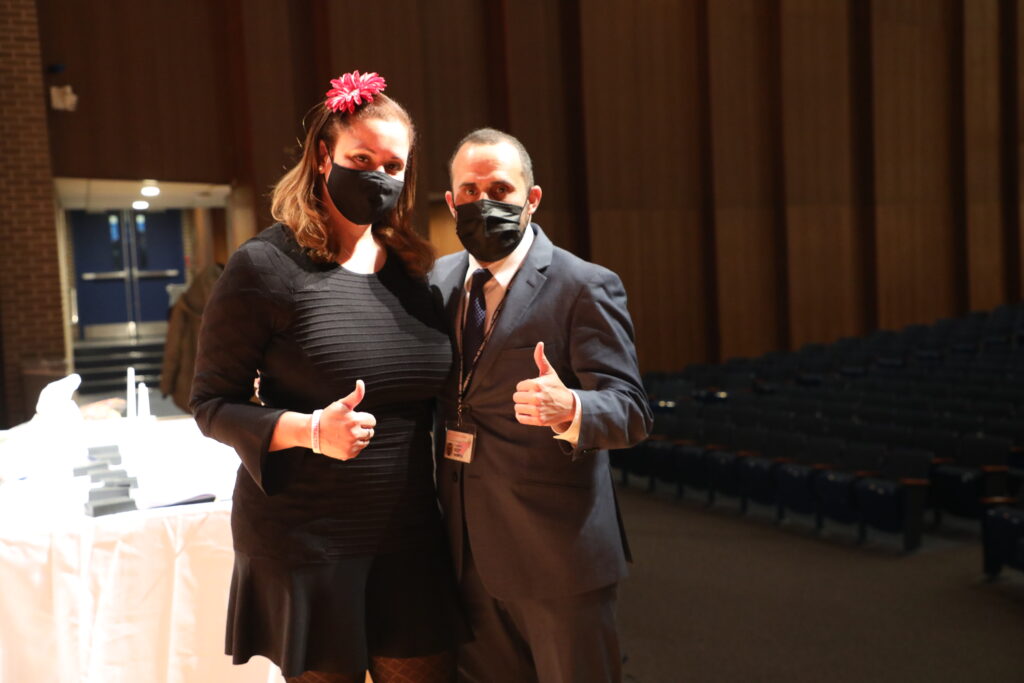
Teacher Leader Dr. Johanna Amaro with Evergreen School Vice Principal Juanpablo Jimenez in Plainfield. (Photo by Gloria Montealegre, PPS)
Gerbig sums it up best when she says, “It’s important to have the conversations and have the professional development—examine our pedagogy and our classroom resources. We must examine what our classrooms look like so that they reflect the students in our classrooms, the communities in which we teach, and the world beyond.”
Leading in healing communities
As an English language learner (ELL) teacher, Dr. Johanna Amaro found herself at the intersection of several NJEA programs that have transformed her teaching and leadership practice. Her school in Plainfield was an NJEA Priority School, a program that supported challenged schools by creating leadership teams and providing coaching support for educators. Amaro credits the TLA with giving her the skills to negotiate her way through the leadership team and support her colleagues and students.
Amaro found that these skills along with the learning she had done with NJEA around adverse childhood experiences (ACEs) and healing-centered schools were the combination she needed to help the school to create a community focused on the healing and support of students during the pandemic. The leadership team would meet in a virtual circle to develop strategies to support staff and students. She put that experience of circle practice to use with both her colleagues and her students—a practice that has continued with her students as well to build community following the time away from school.
Redefining leadership
Christin Walsh has been an educator for 19 years, and most recently served as a reading specialist in the Manasquan School District. Through the pandemic, and when she was attending the TLA, her job responsibility shifted to teaching second and third grades in an online environment.
Walsh has always found herself in leadership positions, whether it be through her local association or through assorted committee work in the district. Trying to negotiate her way through several leadership opportunities, she struggled with the question of moving into administration. In her discernment process she came to a realization: “I can teach people to read. Why would I want to spend my time as a vice principal dealing with nothing but discipline?”
That realization shifted the way Walsh saw her new role in leadership emerge. In meeting with her superintendent, she was able to articulate her passion for education in the district and the role she could play in her school in helping to build the capacity of her peers. New building administrators, who had experience with instructional coaches in their former districts cemented the deal, and Walsh’s role as a reading specialist morphed into supporting colleagues as much as supporting struggling readers.
Running the Intervention and Referral Services team, supporting the staff with new Tier 1 interventions, and coaching teachers in new assignments are among some of the responsibilities Walsh has taken on. She has a laundry list of new initiatives and projects that she sees as possibilities. They are the kinds of possibilities that people only see when they are occupying the seat of a teacher, as opposed to an administrator who is separated just enough from the everyday work of teaching and learning.
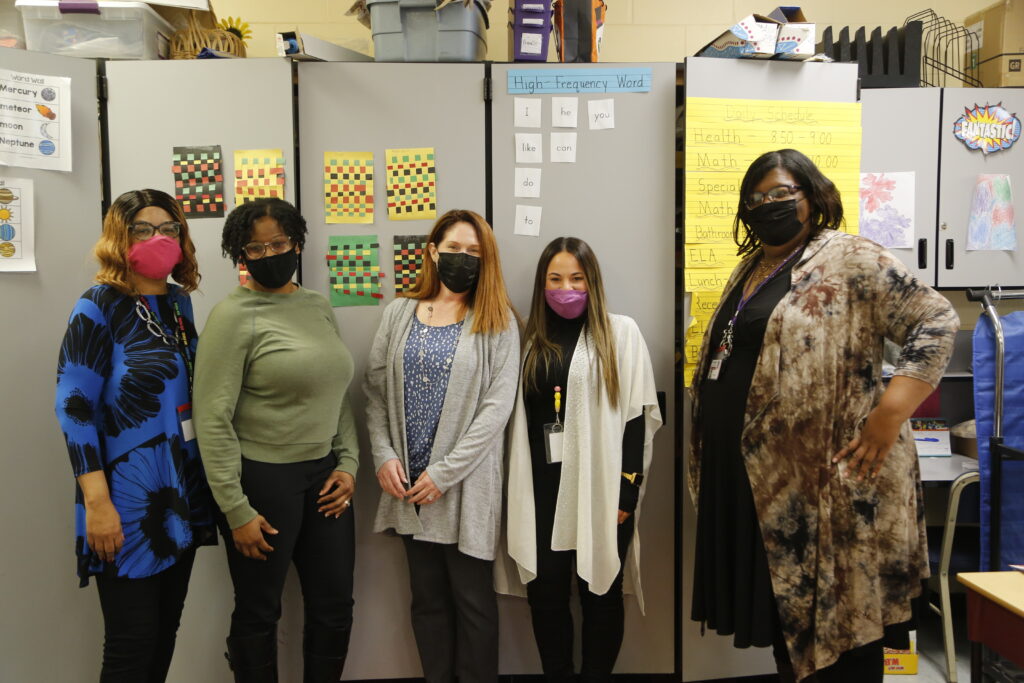
Teacher Leader Syreeta Primas with staff at Leeds Avenue Elementary School in Pleasantville. From left Patricia Davis, Romise Austin, Jennifer Dunn, Amanda Lenahan, and Primas.
Leading from every seat
A key belief of the TLA is that there is a leader in every seat, but some people are destined to lead from every seat in which they sit. Teacher leadership can show itself both inside and outside the school district, building capacity among individual colleagues as well as leading for systemic change. A perfect example is Syreeta Primas who has served as the team leader of her first-grade team in Pleasantville for many years. This was the place where she saw her leadership when she entered the TLA in January 2020. She also has done her part in her union, serving as an association representative.
Through the TLA Primas recognized more of her leadership potential. Being the kind of person who always says “Yes,” she has found herself in more and more leadership roles both in and out of the school building.
Inside of the district, she mentors new teachers, and this year is yet again mentoring a novice teacher. Taking the notion of “a leader in every seat,” Primas understood that one job of a teacher leader is to discover and build the leadership skills of others. The novice teacher that Primas is mentoring this year is, as she describes it, “a tech genius,” so Primas went right to work to integrate the teacher into the team and let her share her skills so that the rest of the first-grade team saw her value and embraced her as well.
This year, Primas upped the ante in her union leadership, serving as a vice president of her local. When there was a change in leadership at the district level, she decided to use the influence of her association position to meet with a new superintendent with a focus on building morale and creating a culture in which her colleagues feel valued, so they can be successful with their students.
Primas’ leadership does not end at the door of her school building, or even within the boundaries of her school district. An interview to tutor with an outside nonprofit, Future Leaders, that provides leadership and tutoring opportunities for students in her district turned into a much greater opportunity for Primas to have an impact on both students and her school district. As she described her work with the TLA she got hired, but she is doing far more than tutoring. Primas is creating curricula and connecting with teachers throughout the district to act as a liaison between the Pleasantville School District and Future Leaders. This ensures that Future Leaders can create curricula that supports the district students.
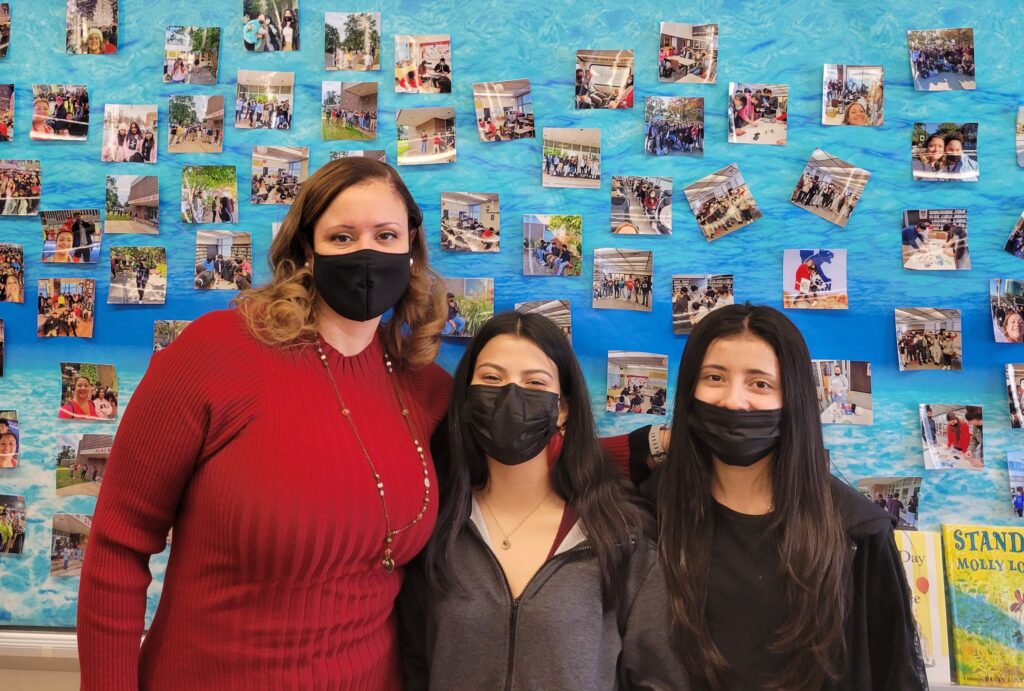
Teacher Leader Dr. Johanna Amara with Plainfield High School seniors, Emily and Naidelyn.
Finding your value as a leader
For some, shifting to a more formal teacher leader role is not possible in the district where they had been teaching. This was the case for Brittany Bloss, who had been looking to exert her teacher leadership through an instructional coaching position. In the middle of last year, she learned of a position in Howell, a district not too far from her home.
From the start, Bloss credits the learning from the TLA for helping her make it through the interview process and in her now current position as a middle school math coach. When she recounts the story of her interview process, she says that every question she was asked was a topic covered in the TLA curriculum. She has found that every challenge in this new position was also something that was addressed in the TLA program. Bloss is particularly proud that she is only the second instructional coach ever hired from outside the district, and of the outside hires, the only one without prior coaching experience.
As a math instructional coach, Bloss works in one building supporting anyone who teaches math, either directly or as part broader job classification. That means providing resources for math teachers as well as special education and ELL teachers in implementing a new math curriculum as well as heading up the response to intervention process for math. She is also able to work in the classroom with some of the struggling math students.
Bloss describes her process of coaching as helping teachers form their goals and work toward them. She is working hard to not be seen as a supervisor, which means building trust with her colleagues.
Bloss describes the TLA as “yearlong professional development—the growth I took away as a person; I changed in my listening, my availability, how I hear people, how I communicate with people, how I honor other people’s voices and vision and lift other people up. It’s so much more than learning reading strategies; it was a life changing year.”
That awakening has been particularly important in dealing with the impact the pandemic has had on school culture. She describes a common symptom of trauma as going inward and isolating oneself. This conflicts with what we know from the research: schools work best when there is a sense of collective efficacy among the staff. As an instructional coach, she sees it as part of her responsibility to create space where teachers can come together and reestablish their relationships, so they can build those communities in their classrooms to lead to healthier students and better learning.
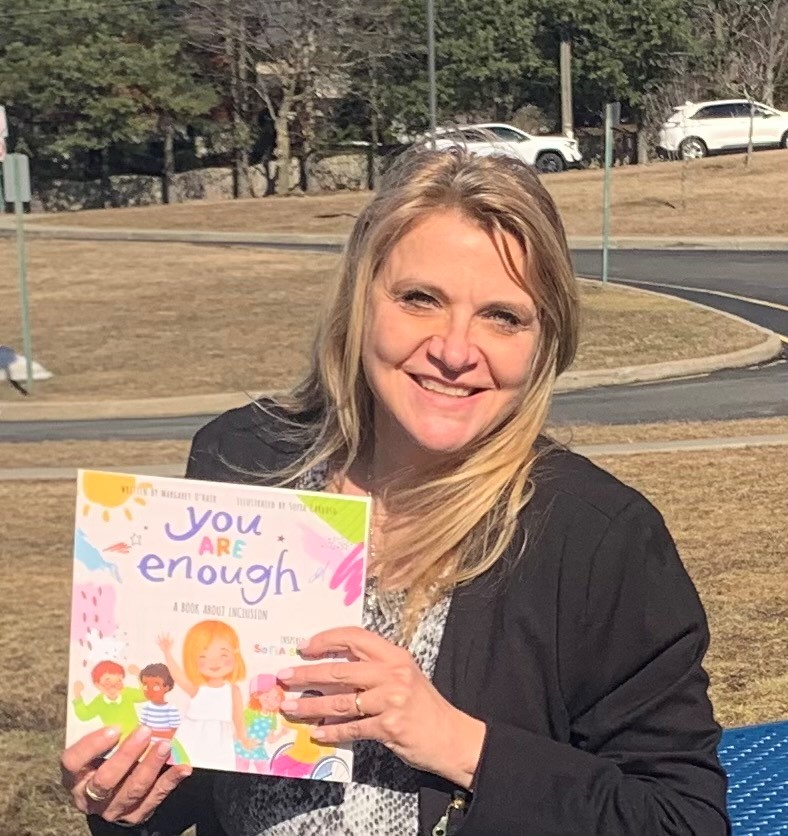
Local, state, and national leadership
Lateefah Scott in Atlantic City found herself stepping into leadership roles both within and outside her school district. Scott had been a participant in the NEA Leaders for Just Schools program, but the skills and knowledge she had gained in the TLA gave her the confidence to seek out the role of facilitator in that program. As such, she works with educators from across the country to dive into understanding equity, to investigate how bias impacts the conditions of teaching and learning, and to explore ways in which they can improve school culture so that every student has the opportunity to succeed. As a facilitator, she not only leads workshops, she builds ongoing relationships among educators across the country and works with them to develop and implement plans to create more just schools.
Scott’s knowledge of adult learning and professional development, combined with her passion for equity within the union, was the perfect combination for her to seek opportunities to provide workshops for the statewide NJEA Members of Color (MOC) Network. One of her aims with MOC was to facilitate sessions on navigating the union at the local level as a member of color. Within her own school district, she shifts that knowledge of adult learning to host sessions for co-teachers on how to work together as a team.
On the local level, Scott continues to take her skills and apply them to supporting her colleagues and her school district. She has collaborated with her district in developing NJEA FAST programs (Families and Schools Together) as well as providing workshops in co-teaching for her colleagues.
The challenge of defining teacher leadership
Looking at this small sample demonstrates the challenge of defining “teacher leadership” and any attempt to attach a set of specific responsibilities to holding the teacher leader endorsement. At the same time, it also shows the value of participating in a high-quality teacher leader program.
These teacher leaders also reveal the potential to consider a new paradigm for school leadership. Consider the possibilities for schools and our students if we shifted from the hierarchical structures in schools and truly embraced the notion of a leader in every seat.
Richard Wilson is an associate director in the NJEA Professional Development and Instructional Issues Division. He is the coordinator of the NJEA Teacher Leader Academy. He can be reached at TeacherLeader@njea.org.
Apply to join the NJEA Teacher Leader Academy
Has this article sparked your interest in pursuing the teacher leader endorsement?
The NJEA Teacher Leader Academy is a New Jersey Department of Education approved one-year program for candidates seeking to earn the teacher leader endorsement. Through the program you can also earn 12 graduate credits from Thomas Edison State College.
Teacher leaders create new models of professional learning, develop new systems to monitor student progress, connect with families and communities, and advocate for the profession.
Join the NJEA Teacher Leader Academy and collaborate with fellow educators who are finding ways to lead from the classroom as they share ideas, support their colleagues, and work with school and district leaders to create systemic change that will support high-quality teaching and learning.
A new cohort begins this July. The application deadline is May 15.
For more information and to apply, visit njea.org/tla. Questions? Write to teacherleader@njea.org.
